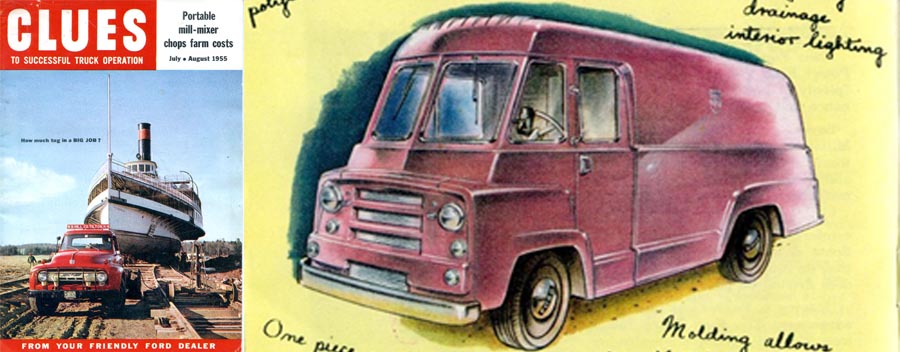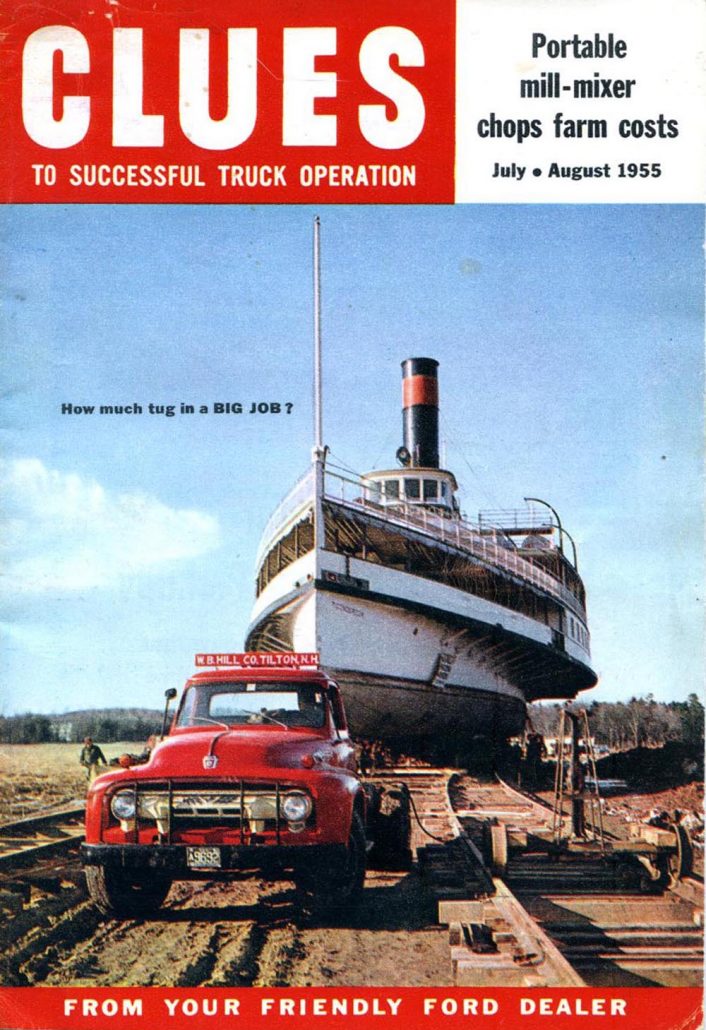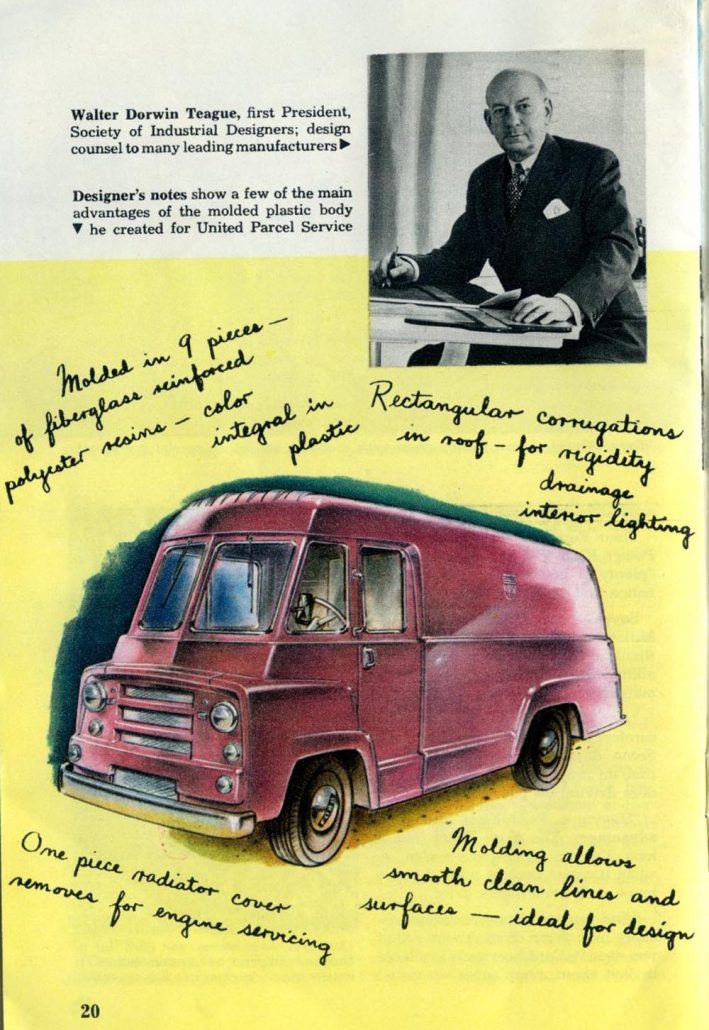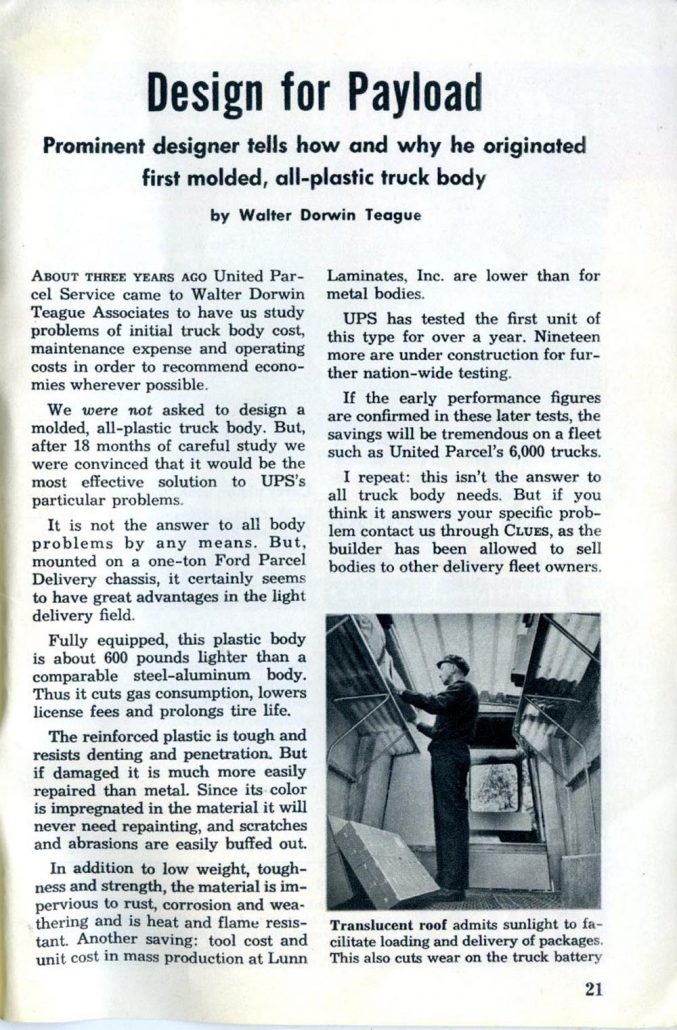
Hi Gang…
Forgotten Fiberglass research takes us to all ends of the earth – and to little known magazines too. Several years ago good fiber-friend Glenn Brummer alerted me to a magazine I’d not heard of before – “CLUES.” It was geared toward the truck owner in the 50s and it’s still new to me – but I’m glad we found it.
For in the hidden pages of this long-lost tome was a story untold for decades – a story of the first fully built fiberglass truck and the man who designed it – well known industrial designer Walter Dorin Teague – famous for his design (son’s design) of the Marmon V16 car from the 1930s.
Let’s have a look at the story about one of the earliest – if not the earliest – fiberglass bodied trucks – penned by Walter Dorrin Teague himself. And away we go…
Design For Payload
Clues To Successful Truck Operation: July-August 1955
Prominent Designer Tells How and Why He Originated First Molded All-Plastic Truck Body
By Walter Dorin Teague
About three years ago, United Parcel Service came to Walter Dorwin Teague Associates to have us study problems of initial truck body cost, maintenance expense and operating costs in order to recommend economies wherever possible.
We were not asked to design a molded, all-plastic truck body. But, after 18 months of careful study we were convinced that it would be the most effective solution to UPS’s particular problem. It is not the answer to all body problems by any means. But, mounted on a one-ton Ford Parcel Delivery chassis, it certainly seems to have great advantages in the light delivery field.
Fully equipped, this plastic body is about 600 pounds lighter than a comparable steel-aluminum body. Thus it cuts gas consumption, lowers license fees and prolongs tire life.
The reinforced plastic is tough and resists denting and penetration. But if damaged it is much more easily repaired than metal. Since its color is impregnated in the material it will never need repainting, and scratches and abrasions are easily buffed out.
In addition to low weigh, toughness and strength, the material is impervious to rust, corrosion and weathering and is heat and flame resistant. Another saving: tool cost and unit cost in mass production at Lunn Laminates, Inc.
UPS has tested the first unit of this type for over a year. Nineteen more are under construction for further nationwide testing. If the early performance figures are confirmed in these later tests, the savings will be tremendous on a fleet such as United Parcel’s 6000 trucks.
I repeat: this isn’t the answer to all truck body needs. But if you think it answers your specific problem contact us through CLUES, as the builder has been allowed to sell bodies to other delivery fleet owners.
Captions Around Truck Illustration:
- Molded in 9 pieces of fiberglass reinforced polyester resins – color integral in plastic
- Rectangular corrugations in roof for rigidity, drainage, and interior lighting
- One piece radiator cover removes for engine servicing
- Molding allows smooth clean lines and surfaced – ideal for design
Summary:
So how many of these trucks were finally built? How many are left? If they started a year before this article was published, this would give us the year 1954 for these trucks – very early indeed – and it may be the first all-plastic truck.
Should Rick D’Louhy and I find one and give the guys at American Pickers a run for their money with our vintage fiber-truck criss-crossing America in search of long lost fiber-treasure?
And I’m glad they mentioned who built the prototype – Lunn Laminates. This company should be familiar to some of you. Lunn Laminates built their first fiberglass car – the 1952 Rockefeller Yankee – before their next more famous car – the Corvette. And to know they were involved in this fiberglass truck prototype is pretty neat. I’m on the lookout for the family of those who ran Lunn Laminates in hopes of photos they may have. And if we find them….
These stories and more will be reviewed in future posts here at Forgotten Fiberglass
Thanks again to Glenn Brummer for making today’s post possible, hope you enjoyed the story, and until next time…
Glass on gang…
Geoff







Great post! I’m a big fan of classic trucks and I’ve always been interested in how they were built. It sounds like fiberglass was a go-to material of the time. I can see why, though, since a lot of the outside of the truck doesn’t need to be extremely strong. I’m sure it’s a cheap option as well.
Hello Mr.Hacker,
My father, who just passed away in Feb. 2014, worked for Lunn Industries(formerly known as Lunn Laminates)in Huntington and Wyandanch, NY. He was with Lunn for 36 years eventually as Lunn’s Chief Engineer. I do believe that we have some information in his files upstairs as to the history and projects that Lunn had worked on over their many years including the UPS trucks.
When I was a kid, Dad would travel between the Huntington plant on Oakwood Road and their Ashtabula, Ohio facility working on the Corvette body components. Let me know if you may be interested in the information that may be in his files.
Several commercial bakeries here in Southern California used bread trucks that were ALL fiberglass save for the sliding door, frame, and rear bi-fold doors made by a company called “American Body Works” out of Lynwood California. Most were on a Chevrolet chassis with dual wheels, they were quite unique and looked kind of cool.
Ramon…I’d love to see some photos of the fiber-trucks if you can find any. Sounds like they would be worth posting a story about. If you can find some photos, I’ll do the research for an article. Hope you can help and thanks for your post. Geoff
I worked for UPS in Portland, Oregon from 1961 through 2002, and when I started Portland had one of these trucks (Seattle also had one). We UPS drivers nicknamed ours “the plastic pig” because it was so light that traction was poor, resulting in spinning wheels when starting out and skidding wheels when stopping in low traction conditions such as rain and wet leaves, etc. Rumor was that UPS had five of these still in service in the early sixties and that they were the result of an experiment that had failed. Supposedly during loading in Chicago in the wintertime the sides shattered when they were impacted, and in in Phoenix the sides sagged outward when loaded during the hot summer weather. Therefore, the remaining trucks were sent to mild weather locations to finish out their lives. I wish I could recall more but, alas, after over fifty years my recollection is vague. I appreciate this article – I always wondered how and why UPS had them in their fleet. Of course, we also had a VW Microbus back then, although my truck (referred to as a package car by UPS) was an International (mine was a 1948 model), as was most of the fleet. UPS relied on aluminum sides instead of fiberglass after this when it started designing its own package cars and used fiberglass for the front ends as it still does today.
@Jack Minor – Thanks for the added detail Jack. It’s great to learn that more than one was made. Do you know anyone at UPS who might have photos of these trucks? All I could find was in the article I shared. And…it would be exciting if we could find a survivor – probably used as storage in a truck junkyard, but it would great to find this piece of history too – no matter the condition. Thanks for sharing your memories.
Geoff Hacker
Forgotten Fiberglass
Until I started receiving these emails of Forgotten Fiberglass I had no idea there were so many cars “and now” trucks produced back in the 40’s through 60’s. Nice job on compiling all this info. I think you have a makings of a TV show here that people would really like to see. Keep up the good work.
A very good friend of mine in Southern California was Dix Helland. Dix had been with Hudson as a field instructor to dealership service departments in the early ’50s. As I recall his next position regarded the truck fleet of UPS. Dix has been gone for most of the last decade. It is probable that he worked with or consulted with this project. Though not a stylist, the fiberglass front ends of three decades of UPS trucks he claimed as his work and he also worked on their complex computerized daily routing. Between their efficient aero front trucks and routing, Dix was responsible for incredible corporate fuel savings. His retirement near the beach in SoCal was of a very high quality due to the salary he had earned and the bonuses he had been awarded. Unfortunate we can’t ask him for his input on this story!
great find, great history, great job – yours and teague’s